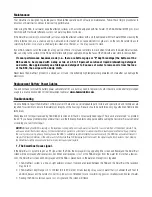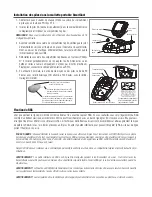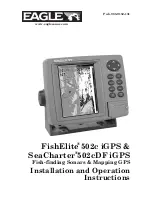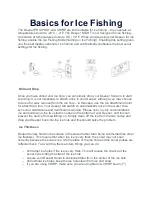
Maintenance
Your SmartCast is designed to provide years of trouble-free operation with virtually no maintenance. Follow these simple procedures to
ensure your SmartCast continues to deliver top performance.
After using the RSS in salt water, wipe the affected surfaces with a cloth dampened with fresh water. The RSS Wet SwitchTM pins must
be rinsed with fresh water after exposure to salt water to prevent corrosion.
If the SmartCast comes into contact with salt spray, wipe the affected surfaces with a cloth dampened with fresh water. When cleaning the
LCD protective lens, use a chamois and non-abrasive, mild cleaner. Do not wipe while dirt or grease is on the lens. Be careful to avoid
scratching the lens. Do not use a chemical glass cleaner on the lens, as this may cause it to crack.
If your RSS remains out of the water for a long period of time, it may take some time to wet it when returned to the water. Small air bub-
bles can cling to the surface of the RSS and interfere with proper operation. Wipe the face of the RSS with a wet cloth to remove them.
If sonar performance becomes weak (i.e., there are bottom gaps or "0" depth readings) the bottom of the
RSS needs to be cleaned with a drop or two of a 5 to 10 percent solution of liquid dishwashing detergent
and water. Use approximately one tablespoon detergent to 8 ounces of water to remove oils from the face
of the RSS, then wipe with a damp cloth.
Never leave the SmartCast product in a closed car or trunk - the extremely high temperatures generated in hot weather can damage the
electronics.
Replacement Battery Power Cables
You will not have to install the battery power cable before first use, but may need to replace it should it become corroded after prolonged
usage in a marine environment. Order replacement cables at
www.humminbird.com
.
Troubleshooting
Do not attempt to repair the SmartCast or RSS yourself. There are no user serviceable parts inside, and special tools and techniques are
required for assembly to ensure the waterproof integrity of the housings. Repairs should be performed only by authorized Humminbird
technicians.
Many requests for repair received by Humminbird involve units that do not actually need repair. These units are returned “no problem
found.” If you have a problem with your SmartCast, use the following troubleshooting guide before calling the Customer Resource Center
or sending your unit in for repair.
NOTE:
Retrieving the RSS too rapidly, or the repetitive rocking motion of rough water, can result in loss or distortion of the bottom picture. This
will cause intermittent screen display. For best bottom detail, perform a smooth and slow reel-in with constant speed and the rod tip up (holding
the rod tip low or using a heavy line may cause the RSS to submerge and momentarily lose radio contact). The RSS has a maximum transmit
range of 100 feet (30 meters). If the unit is cast or drifts more than 100 feet away from the receiver, the signal may be inconsistent or lost. Raising
the SmartCast slightly above ground level will also increase signal capture.
1. The SmartCast loses signal.
If the SmartCast is not able to get an RF signal from the RSS, the display will stop updating (the screen will freeze) and the SmartCast
screen will be displayed after several seconds. Whenever reception is lost or the RSS emerges from the water for more than a few sec-
onds, the SmartCast screen will be displayed until the RSS is placed back in the water and reception is regained.
• The SmartCast system is a line-of-sight wireless product. If objects are placed between the RSS and the SmartCast, the reception
may be lost.
• The SmartCast depth range is 2 to 100 feet (0.6 to 30 meters). Erratic readings may occur in water that is shallower than 2 feet. In
addition, because of the nature of sonar, this product is not intended for use in swimming pools or small enclosed bodies of water.
• Reeling the RSS too fast can cause loss of signal and the screen will freeze


























